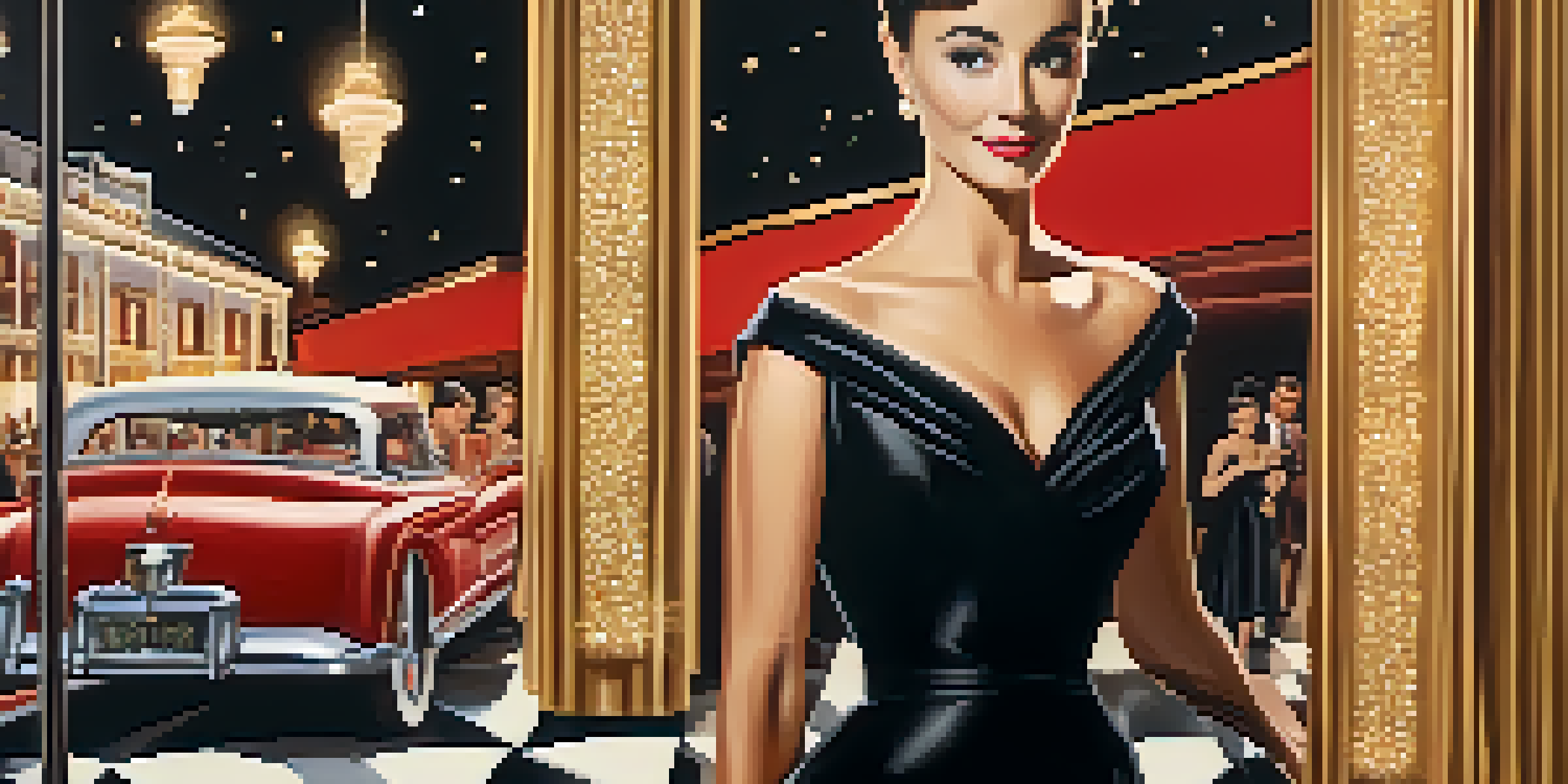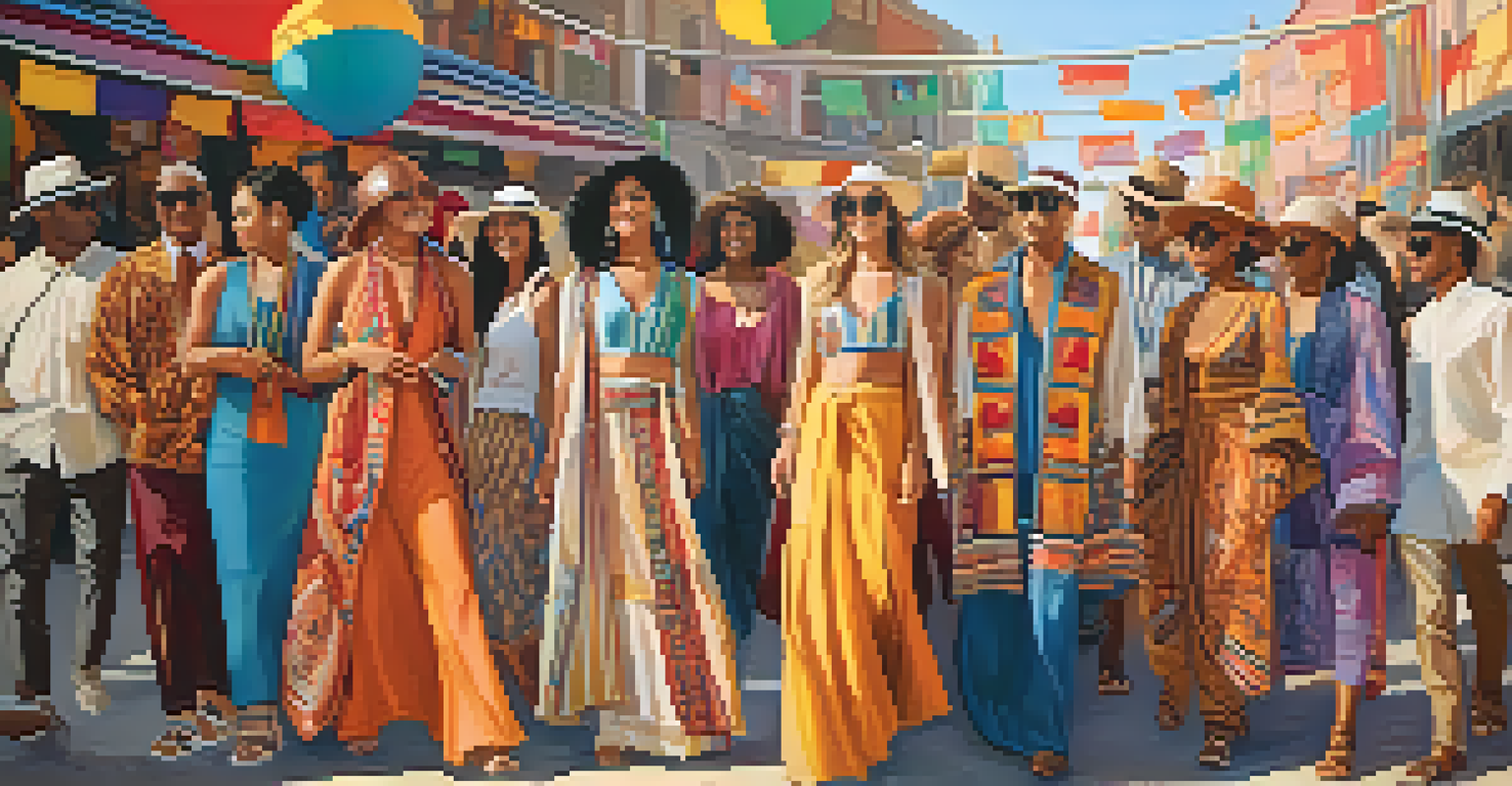Fashion Movements Reflected in Film: A Cultural Analysis

The Golden Age of Hollywood: Glamour and Style
The Golden Age of Hollywood, spanning from the 1920s to the 1960s, showcased fashion as a symbol of glamour and aspiration. Iconic figures like Audrey Hepburn and Marilyn Monroe not only captivated audiences with their performances but also set trends that defined an era. Their elegant styles became aspirational for women worldwide, showcasing the power of film in shaping public taste.
Fashion is the armor to survive the reality of everyday life.
Costume designers, such as Edith Head, played a crucial role in this phenomenon, creating memorable outfits that told stories and enhanced character development. For instance, Hepburn's little black dress in 'Breakfast at Tiffany's' remains a timeless symbol of chic sophistication. This demonstrates how film can elevate fashion from mere clothing to an art form that resonates culturally.
As these films reached audiences globally, they influenced everyday fashion, leading to a rise in tailored silhouettes and elegance in the mid-20th century. This dynamic exchange between film and fashion not only reflected societal values but also shaped them, showing the profound impact of cinema on cultural identity.
The Rise of Counterculture in Cinema
The 1960s and 1970s brought about a shift in film and fashion, marked by counterculture movements that challenged norms. Films like 'Easy Rider' and 'The Graduate' showcased a more relaxed, rebellious style, with denim and casual wear becoming symbols of youth liberation. This shift in fashion reflected broader societal changes as young people sought to break free from traditional constraints.

As the anti-establishment sentiments grew, so did the desire for individuality in fashion. Designers like Mary Quant and Yves Saint Laurent embraced this ethos, introducing bold colors and unisex styles that mirrored the narratives on screen. The fusion of film and fashion during this period highlighted the power of visual storytelling in shaping cultural movements.
Fashion as Cultural Reflection
Throughout cinema history, fashion has mirrored societal values and aspirations, influencing everyday styles and cultural identity.
Moreover, the influence of music on film fashion was undeniable, as rock 'n' roll icons like Jimi Hendrix and Janis Joplin inspired a generation. This era exemplified how film could serve as a canvas for expressing personal and political identities, making fashion a vital part of the cultural dialogue.
The Impact of Fashion in the 1980s Blockbusters
The 1980s ushered in a wave of blockbuster films that not only entertained but also set fashion trends that defined the decade. Movies like 'Flashdance' and 'The Breakfast Club' introduced vibrant colors, oversized silhouettes, and athleisure wear, reflecting the energetic spirit of the time. This era marked a significant shift where fashion became a central narrative device in cinema.
Style is a way to say who you are without having to speak.
The rise of iconic characters, such as Jennifer Beals’ Alex in 'Flashdance', inspired countless fans to adopt similar styles, showcasing how film can drive consumer behavior. The 80s also saw the emergence of fashion designers collaborating with filmmakers, creating a symbiotic relationship that further propelled fashion into the mainstream. This collaboration resulted in a heightened awareness of fashion as a vital part of cinematic storytelling.
As audiences embraced these bold styles, they became emblematic of youth culture and empowerment, signaling that fashion could be both a personal expression and a collective identity. The 1980s exemplified how film not only reflects but also actively shapes contemporary fashion movements.
1990s Grunge: Fashion's Rebellion on Screen
The 1990s brought forth the grunge movement, a stark contrast to the glam of previous decades, and films like 'Reality Bites' and 'Clerks' captured this shift. Grunge fashion, characterized by flannel shirts, combat boots, and thrift store finds, resonated with a generation seeking authenticity. These films portrayed characters who embraced a laid-back, anti-fashion ethos that challenged mainstream ideals.
Designers like Marc Jacobs and companies like Urban Outfitters capitalized on this trend, bringing grunge aesthetics into the fashion spotlight. The influence of music, particularly bands like Nirvana, further cemented this style's place in culture, illustrating how film and fashion often intersect with music to create powerful movements. This cross-pollination of influences showcased the rebellious spirit of the era.
Counterculture's Fashion Revolution
The 1960s and 1970s saw a shift towards individuality in fashion, driven by counterculture movements that challenged traditional norms.
Grunge's impact on film and fashion highlighted the importance of embracing individuality over conformity. As viewers connected with the characters on screen, they found inspiration in their wardrobe choices, demonstrating how film can empower audiences to express their unique identities through style.
2000s: The Rise of Fast Fashion and Film
Entering the 2000s, the film industry saw the emergence of fast fashion, where trends evolved rapidly and were accessible to the masses. Movies like 'The Devil Wears Prada' not only entertained but also scrutinized the fashion industry, revealing the behind-the-scenes dynamics of trendsetting. This film specifically showcased how fashion can be both an art form and a commercial enterprise, reflecting society's complex relationship with style.
As fashion became more accessible, films began to influence consumer behavior in unprecedented ways. Characters like Anne Hathaway's Andy Sachs inspired viewers to emulate their style, leading to a surge in fast fashion consumption. This phenomenon illustrated how cinema could drive trends, often prioritizing immediacy over sustainability, raising questions about the long-term impact on the fashion industry.
Moreover, the proliferation of social media during this time allowed audiences to engage with fashion in real-time, creating a feedback loop between film, fashion, and consumer trends. This interplay revealed the evolving nature of cultural consumption, where film not only reflects fashion but also shapes it in a digital age.
Fashion and Identity in Contemporary Cinema
In contemporary cinema, fashion has become a powerful tool for exploring identity and social issues. Films like 'Black Panther' and 'Crazy Rich Asians' not only showcase stunning costumes but also delve into cultural heritage and representation. Through fashion, these films celebrate diversity and challenge stereotypes, illustrating how style can communicate complex narratives.
Designers are now collaborating more closely with filmmakers to ensure authenticity in representation. For instance, Ruth E. Carter's work in 'Black Panther' received acclaim for its rich cultural references, demonstrating how fashion can serve as a narrative device that connects viewers to the story. This evolution signifies a growing awareness of the importance of cultural sensitivity in film and fashion.
Sustainability in Future Fashion
As the film and fashion industries evolve, there is a growing emphasis on sustainability and ethical practices to meet changing consumer values.
Furthermore, the rise of inclusive fashion in cinema has opened doors for broader representation. As audiences demand more diverse narratives, filmmakers are responding by incorporating various styles that resonate with different cultural backgrounds. This shift not only enriches storytelling but also highlights the role of fashion in shaping contemporary identities.
The Future of Fashion Movements in Film
Looking ahead, the relationship between fashion and film continues to evolve, driven by technological advancements and changing consumer values. With the rise of virtual reality and digital fashion, filmmakers are exploring new ways to integrate style into storytelling. This innovative approach could redefine how audiences experience fashion in cinema, breaking traditional boundaries.
Sustainability is also becoming a focal point in both industries, as filmmakers and designers alike strive to create more environmentally conscious narratives. Films that highlight ethical fashion practices are gaining traction, reflecting a societal shift towards responsible consumption. This trend indicates a growing recognition of the impact of fashion choices on the planet.

As we move into the future, the interplay between fashion and film will likely continue to shape cultural movements, encouraging dialogue around identity, sustainability, and creativity. This ongoing relationship ensures that fashion remains a vital aspect of storytelling, resonating with audiences in meaningful ways.